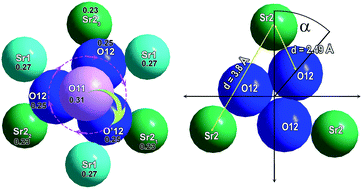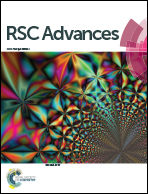Sr9In(VO4)7 as a model ferroelectric in the structural family of β-Ca3(PO4)2-type phosphates and vanadates†
Abstract
Sr9In(VO4)7 was prepared by a solid-state method at 1270 K in air. This vanadate has the β-Ca3(PO4)2-type structure and crystallizes in polar space group R3c. The structural parameters of Sr9In(VO4)7 were refined by the Rietveld method from laboratory powder X-ray diffraction data (XRD): the lattice parameters are a = 11.18016(9) Å and c = 39.6170(3) Å with Z = 6. In3+ cations occupy the octahedral M5 site, Sr2+ cations occupy the M1, M2, and M3 sites of the β-Ca3(PO4)2-type structure, and the M4 site remains vacant. Sr9In(VO4)7 was characterized by differential thermal analysis (DTA), optical second-harmonic generation (SHG), high-temperature XRD, and dielectric measurements. All these methods prove the existence of a ferroelectric–paraelectric phase transition at Tc = 974 K. This transition is compared with a similar transition in Ca9In(PO4)7 with lower Tc = 902 K. The polar-to-centrosymmetric phase transition in such compounds has a quite unique mechanism of the order–disorder type. The structural transition involves slight shifts of the M1, M2, M3 cations and the E2O4, E3O4 tetrahedra, while half of the E1O4 tetrahedra (E = P or V) statistically reverse their orientation along the three-fold axis, so that the centre of symmetry appears in the structure as a whole. To invert the E1O4 tetrahedron, one oxygen anion should pass a large neighbouring cation (Sr2+ or Ca2+) that is only possible when intense rotational vibrations of the tetrahedra are excited at high temperatures. The lower Curie temperature in Ca9In(PO4)7 corresponds to the smaller rotational vibration amplitude of the P1O4 tetrahedron required to reverse this tetrahedra at Tc in comparison with V1O4 in Sr9In(VO4)7.

- This article is part of the themed collection: Editors' Collection: Ferroelectric and Multiferroic Materials


 Please wait while we load your content...
Please wait while we load your content...